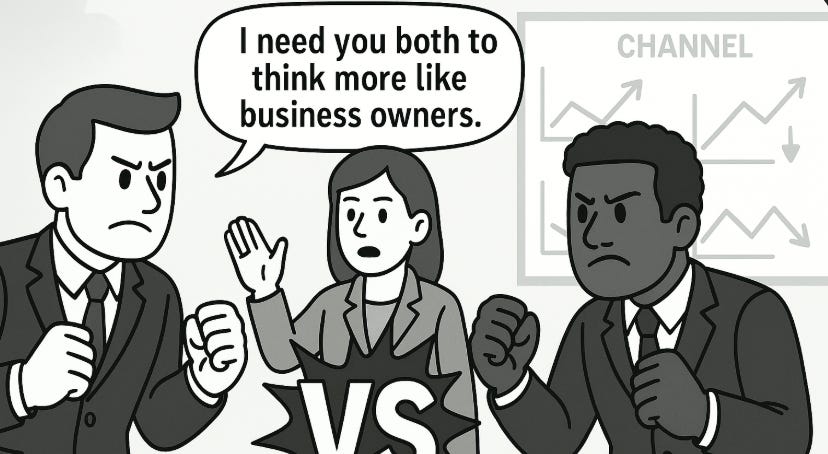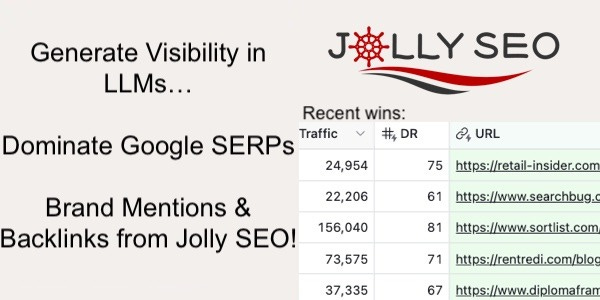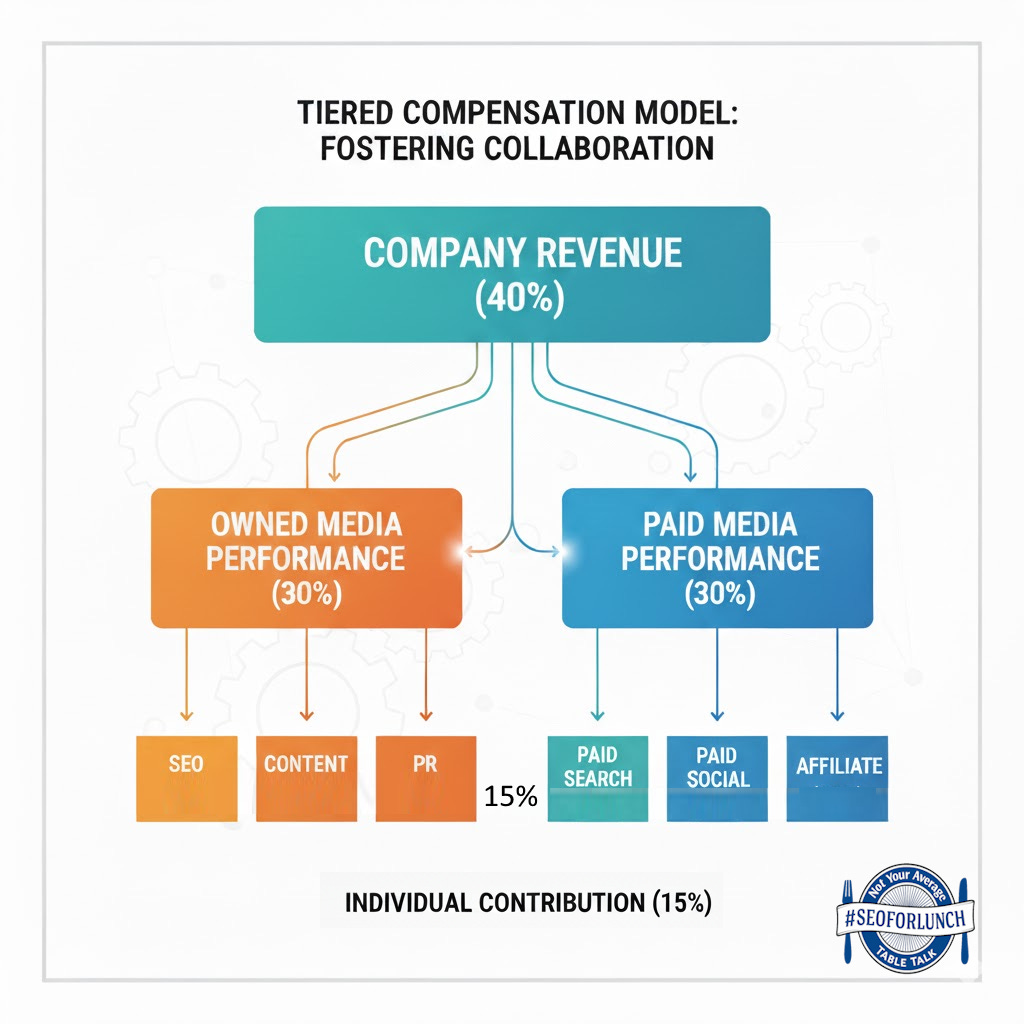Leaders Say They Want Collaboration, But Reward for Competition
Employee performance is often tied to channel-level performance. This kills collaboration as people won't prioritize what doesn't benefit them.
This week’s #SEOForLunch is sponsored by Jolly SEO
Thank you to everyone who sent a kind note about my becoming a finalist in Search Engine Land’s “Search Marketer of the Year” award. Unfortunately, I did not win but it’s just more ammunition to succeed on my own!“Think like a business owner.”
“We can’t justify the current budget if your channel’s performance doesn’t improve.”
If you’ve worked in marketing long enough, you’ve probably heard both lines, maybe from your boss, a C-suite exec, or even the business owner themselves.
Each statement on its own makes sense. But when said together, they’re completely at odds. It’s the classic case of leadership preaching collaboration while rewarding competition.
A Special THANK YOU To This Weeks Sponsor: Jolly SEO
Increase LLM Visibility & Google Rankings!
Co-citations is fancy jargon for your brand mentioned alongside other brands. Yet, co-citations are more than fancy jargon: they increase your brand’s visibility in ChatGPT *and* Google.
At Jolly SEO, we specialize in earning brand mentions & backlinks on high-quality websites. Earn, because we do *not* engage in paid linkbuilding. Beyond traditional outreach, HARO, and Digital PR, we now also work on Reddit.
The same great quality, adapted to the new era of search:
The Leadership Paradox
We get it — when the company wins, we all win. Leadership loves to talk about collaboration and big-picture thinking, but when it’s time for recognition or financial reward, everything funnels back to one thing: channel-level performance.
When leaders say “think like a business owner,” what they really mean is: spend money wisely, act responsibly, and make decisions that protect the company’s integrity (and its bottom line).
But here’s the paradox: annual reviews, promotions, and raises are still tied to channel-specific KPIs — think organic revenue, paid ROAS, email acquisition, and so on.
The result? Employees end up protecting their own numbers instead of the company’s bigger goals… the exact opposite of what leadership claims to want.
How Channel-Level Rewards Kill Collaboration
When you reward channel-level performance, something predictable happens — teams stop prioritizing anything that doesn’t move their KPIs.
Sound familiar?
Paid ignores SEO content requests because they risk short-term ROAS.
SEO avoids helping PR since their placements come with no-follow links.
Email won’t promote content that doesn’t drive CTR or list growth.
Dev deprioritizes SEO fixes because they don’t impact UX metrics.
The result?
You end up with a company full of smart people optimizing for their lane instead of the finish line.
The system quietly turns teammates into competitors.
And while every channel thinks it’s protecting its own numbers, the real loss is the company’s — fewer shared wins, less synergy, and wasted potential.
The Consequences for the Business
By now, it’s crystal clear: rewarding channel-level performance exclusively isn’t just limiting, but it’s detrimental to both employees AND the business.
Instead of collaboration, turf wars erupt. Teams retreat into silos. Great ideas die because they don’t “belong” to the right department. The result? Wasted opportunities, duplicated work/tooling, and overall organizational inefficiencies.
What should have been your company’s greatest advantage, cross-channel collaboration, becomes its Achilles’ heel. A strength turned weakness. A competitive edge dulled by internal politics.
Collaboration shifts from being a core growth driver to a “nice-to-have.” And when incentives don’t align with business goals, everyone loses:
Lost revenue
Lost market share
Lost brand momentum
All because everyone’s too busy protecting good ol’ number one.
Fixing The Incentive Problem: Business Outcomes
I’d love nothing more than to say you can simply tie every employee’s compensation to the company’s success … think of marrying “think like a business owner” to every paycheck.
But that’s not realistic. Not everyone has the appetite for the risk and reward that comes with entrepreneurship. For most people, a job is a job, it pays the bills.
That doesn’t mean incentives have to be all or nothing.
The right approach combines business outcomes + channel performance, rewarding both company-wide impact and individual contribution.
The framework below is a simplified version of a compensation structure that supports business, channel, and individual performance.
Tie Compensation to Business Performance
If you want people to buy into “when the company wins, we all win,” you have to actually pay them when the company wins.
People are motivated by reward. If you want alignment, make the rewards shared.
A business-performance bonus structure does two things:
It attracts people who care about impact, not just tasks.
It filters for those who are comfortable with accountability beyond their channel metrics.
The higher the percentage (reward) is at this level, the more collaboration becomes a requirement, rather than a nice-to-have.
Blend Channel and Cross-Team Performance
Most roles are channel-specific by nature, and that’s fine. But when you make channel-level KPIs a secondary reward rather than the primary one, you start to blur the silo lines in a good way.
You get individuals optimizing for business success first, not personal scoreboard vanity. This is when individuals at all levels start “thinking like a business owner”.
Company-Wide KPIs Everyone Can Rally Around
Revenue Growth / Stock Price: The ultimate reflection of cross-department performance.
Brand Lift: Recognition that awareness and trust take multiple channels working in harmony.
Share of Market: Because growth isn’t a win unless it’s relative to your competition.
Cross-Team KPIs That Drive Collaboration
Assisted Conversions or Revenue — what I like to call quantifying the “Halo Effect.”
Campaign Collaborations — measuring the number and success rate of initiatives that involved two or more departments.
This structure can (and should) evolve with complexity — tiered rewards for individuals, teams, and the organization as a whole… but the principle remains the same. Example model below showing a 40/30/15/15 compensation breakout
The biggest wins happen when everyone’s paycheck depends on the business winning, not just their department.
Yes. This is a lot of work. But “being a business owner” isn’t easy. But the rewards, when done appropriately, are unlimited.




